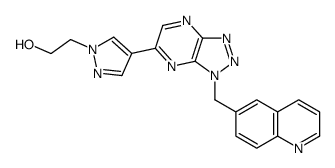| Description |
PF-04217903 phenolsulfonate is a potent ATP-competitive c-Met kinase inhibitor with Ki of 4.8 nM for human c-Met. PF-04217903 phenolsulfonate shows more than 1,000-fold selectivity relative to 208 kinases. Antiangiogenic properties[1][2].
|
| Related Catalog |
|
| Target |
Ki: 4.8 nM (human c-Met)[1]
|
| In Vitro |
PF-04217903 phenolsulfonate (0.1-10000 nM; 48-72 hours) inhibits proliferation of c-Met–amplified human GTL-16 gastric carcinoma and H1993 NSCLC cells with IC50 values of 12 and 30 nM, respectively[1]. PF-04217903 phenolsulfonate (1.5-3333 nM; 48 hours) induces apoptosis of GTL-16 cells (IC50=31 nM)[1]. PF-04217903 phenolsulfonate also inhibits HGF-mediated cell migration and Matrigel invasion in several c-Met–overexpressing tumor cell lines such as human NCI-H441 lung carcinoma and HT29 colon carcinoma with IC50 values comparable with those for inhibition of c-Met phosphorylation in these cell lines (IC50=7-12.5 nM)[1]. PF-04217903 phenolsulfonate displays similar potency to inhibit the activity of c-Met-H1094R, c-Met-R988C, and c-Met-T1010I with IC50 of 3.1 nM, 6.4 nM, and 6.7 nM, respectively. PF-04217903 phenolsulfonate has no inhibitory activity against c-Met-Y1230C with IC50 of >10 μM[3]. Cell Viability Assay[1] Cell Line: GTL-16, H1993 cells Concentration: 0.1, 1, 10, 100, 1000, 10000 nM Incubation Time: 48-72 hours Result: Inhibited proliferation of c-Met–amplified human GTL-16 gastric carcinoma and H1993 NSCLC cells with IC50 values of 12 and 30 nM, respectively. Apoptosis Analysis[1] Cell Line: GTL-16 cells Concentration: 1.5-3333 nM Incubation Time: 48 hours Result: Induced apoptosis of GTL-16 cells.
|
| In Vivo |
PF-04217903 phenolsulfonate (1-30 mg/kg; p.o.; daily for 16 days) shows dose-dependent tumor growth inhibition, which correlated with the inhibition in c-Met phosphorylation in these tumors[1]. PF-04217903 phenolsulfonate (5-50 mg/kg, p.o.; once daily for 3 days) dose dependently inhibits c-Met, Gab-1, Erk1/2, and AKT phosphorylation and induced apoptosis (cleaved caspase-3) in U87MG xenograft tumors at all dose levels. PF-04217903 phenolsulfonate shows a significant dose-dependent reduction of human IL-8 levels in both the U87MG and GTL-16 models and decreases human VEGFA levels in the GTL-16 model. PF-04217903 phenolsulfonate strongly induces phospho-PDGFRβ levels in U87MG xenograft tumors[1]. Animal Model: Female nu/nu mice (GTL-16 xenograft model)[1] Dosage: 1, 3, 10, 30 mg/kg Administration: Oral; daily for 16 days Result: Showed dose-dependent tumor growth inhibition, and was correlated with the inhibition in c-Met phosphorylation in these tumors.
|
| References |
[1]. Zou HY, et al. Sensitivity of selected human tumor models to PF-04217903, a novel selective c-Met kinase inhibitor. Mol Cancer Ther. 2012 Apr;11(4):1036-47. [2]. Cui JJ, et al. Discovery of a novel class of exquisitely selective mesenchymal-epithelial transition factor (c-MET) protein kinase inhibitors and identification of the clinical candidate 2-(4-(1-(quinolin-6-ylmethyl)-1H-[1,2,3]triazolo[4,5-b]pyrazin-6-yl)-1H-pyrazol-1-yl)ethanol (PF-04217903) for the treatment of cancer. J Med Chem. 2012 Sep 27;55(18):8091-109. [3]. Timofeevski SL, et al. Enzymatic characterization of c-Met receptor tyrosine kinase oncogenic mutants and kinetic studies with aminopyridine and triazolopyrazine inhibitors. Biochemistry. 2009 Jun 16;48(23):5339-49.
|
